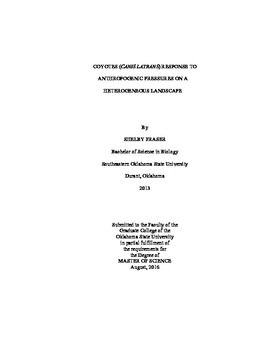| dc.contributor.advisor | Fuhlendorf, Samuel D. | |
| dc.contributor.author | Fraser, Shelby | |
| dc.date.accessioned | 2017-02-22T22:14:45Z | |
| dc.date.available | 2017-02-22T22:14:45Z | |
| dc.date.issued | 2016-08-01 | |
| dc.identifier.uri | https://hdl.handle.net/11244/49075 | |
| dc.description.abstract | Due to the extirpation of many large, native carnivores the coyote has become one of the most widespread and successful predators in North America. They are now considered apex predators in many ecosystems. For this reason, it is important to understand how they respond to natural and anthropogenic disturbances. For this study, ten coyotes were captured, fitted with GPS collars, and monitored for 18 months. By using GIS data from The Nature Conservancy and GPS data from the collars we were able to assess how coyote temporal activities and resource selection were affected by energy development and prescribed fires in the Tallgrass Prairie Preserve (TPP). Based on our data, it is clear coyotes strongly avoided anthropogenic structures on the landscape, but were only weakly affected by prescribed fires, and vegetation type. The coyotes on the nature preserve are also primarily nocturnal, which could be an indicator of temporal activity shifts due to anthropogenic pressures. Our data suggests that the behavior of this coyote population mirrors other studies that have evaluated behavior in relation to human presence. Coyotes represent an emerging shift in top predator species in prairie ecosystems; it is crucial to examine these species in order to understand the changes in behavioral ecology and how these changes affect the ecosystem in novel ways. | |
| dc.format | application/pdf | |
| dc.language | en_US | |
| dc.rights | Copyright is held by the author who has granted the Oklahoma State University Library the non-exclusive right to share this material in its institutional repository. Contact Digital Library Services at lib-dls@okstate.edu or 405-744-9161 for the permission policy on the use, reproduction or distribution of this material. | |
| dc.title | Coyotes (Canis Latrans) Response to Anthropogenic Pressures on a Heterogeneous Landscape | |
| dc.contributor.committeeMember | Fairbanks, W S | |
| dc.contributor.committeeMember | Elmore, Dwayne | |
| osu.filename | Fraser_okstate_0664M_14848.pdf | |
| osu.accesstype | Open Access | |
| dc.description.department | Natural Resources and Ecology Management | |
| dc.type.genre | Thesis | |
| dc.type.material | text | |
